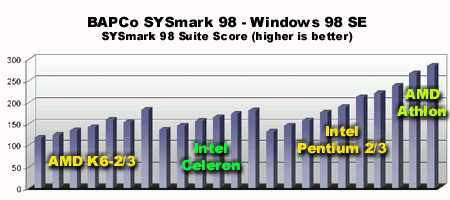Desktop CPU Comparison - September 99
by Anand Lal Shimpi on September 6, 1999 1:23 AM EST- Posted in
- CPUs

The BAPCo SYSmark 98 suite takes quite a few more factors into account than the good ol' Winstone test. Not only does it concentrate on business applications, but there are a handful of "content creation" (i.e. image editing, 3D rendering, OCR, etc...) applications included as well, and those applications help produce a much more well rounded benchmark score.
Due to the FPU and L2 cache intensive nature of some of the applications included in the benchmark and coupling that with the fact that all of the 14 benchmarking applications are weighted evenly in the final score, it isn't too much of a surprise that the K6-2 falls considerably behind in terms of performance. The K6-2 400, 450 and 475 tighten the gap a little, however what you'll notice is the same poor CPU scaling qualities of the K6-2 due to its L2 cache operating at the same frequency regardless of clock speed. A very interesting point to make is that the K6-2 475, in spite of its 5% increase in clock speed, is actually a slower overall solution than the K6-2 due to its 5% decrease in L2 cache speed.
The K6-III makes up for this loss by pulling in a higher score at 450MHz than Intel's fastest Celeron at 500MHz, it seems as if AMD may have some tough competition for Intel's Celeron once the Athlon begins to ship in larger quantities.
The Celeron holds up quite nicely however due to the wide variety of applications that are included in the benchmark, some of which benefited from the faster L2 cache while some desired a larger one, the processor came in around 10 - 15% under an equally clocked Pentium II/III. Once again, the argument of how big of a difference does 10 - 15% realistically add up to can be made and the answer, this time, is much more difficult to give out. It depends entirely on how much you're willing to pay for that added performance boost, also keep in mind that although a processor may rank lower in SYSmark 98 than another, it may actually be faster in one or more of the applications included within the benchmark. So you'll want to check the graphs and the tables from the past few pages to see where your processor choice excels and where it falls short.
Just for kicks we'll point out that the Athlon comes out 10 - 20% faster than the Pentium III, however a 667MHz Pentium III could easily beat the 600MHz Athlon and possibly come very close to doing the same to the 650MHz part. Whoever wins the clock speed battle at the end of 1999 will definitely have the advantage going into the next year, it should be very interesting to watch. As long as prices stay competitive, there's no complaining from the consumer side ;)
Key |
SYSmark 98 |
AMD Athlon 650 |
285 |
AMD Athlon 600 |
267 |
Intel Pentium III 600 |
239 |
Intel Pentium III 550 |
222 |
Intel Pentium III 500 |
212 |
Intel Pentium III 450 |
189 |
Intel Pentium II 400 |
177 |
Intel Pentium II 350 |
158 |
Intel Pentium II 333 |
145 |
Intel Pentium II 300 |
132 |
Intel Celeron 500 |
181 |
Intel Celeron 466 |
173 |
Intel Celeron 433 |
165 |
Intel Celeron 400 |
156 |
Intel Celeron 366 |
146 |
Intel Celeron 333 |
136 |
AMD K6-III 450 |
183 |
AMD K6-2 475 |
153 |
AMD K6-2 450 |
159 |
AMD K6-2 400 |
143 |
AMD K6-2 350 |
134 |
AMD K6-2 333 |
124 |
AMD K6-2 300 |
118 |










0 Comments
View All Comments